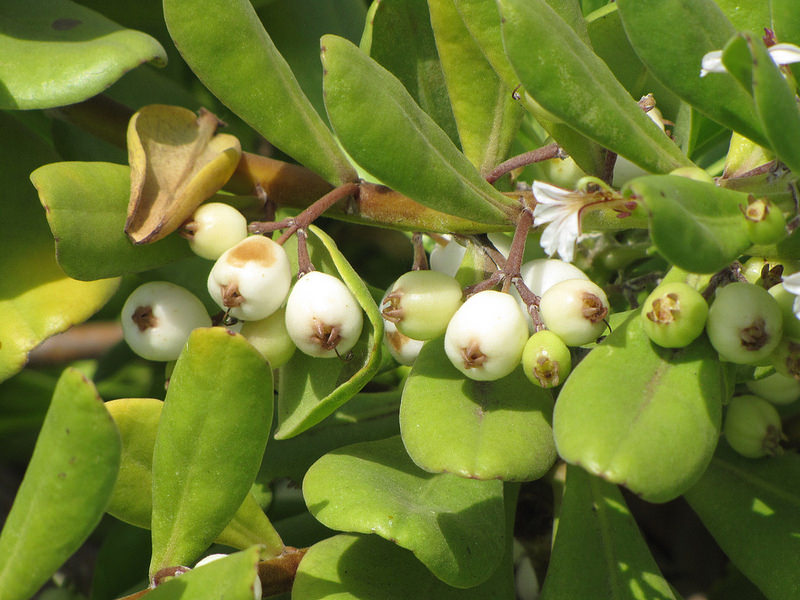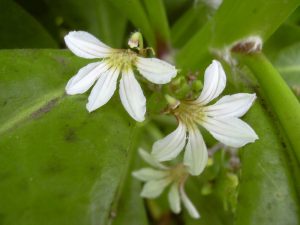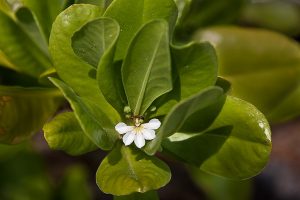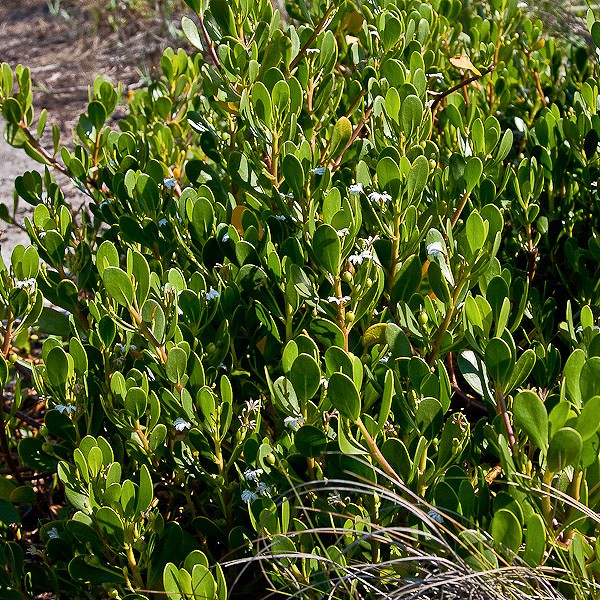Hawaii
Long ago, the buoyant seeds of Scaevola taccada (naupaka kahakai) buoyant seeds floated across the sea: cruising on currents, riding on waves, and finally landing upon distant shores to grow. Modern day studies have shown that naupaka kahakai seeds are most viable after spending an average of 250 days floating in the ocean. This explains why the indigenous species Scaevola taccada has such a wide range.

Scaevola in Latin translates to “left hand.” Common names for genus members include fan-flower, half flower, and naupaka. Hawaiians looked to the half flowers of naupaka species to tell tragic stories of love lost. In one legend of naupaka, two star-crossed lovers are represented by half flowers: one banished to the ocean, the other to the mountain, doomed never to reunite as a whole flower. In another, a scorned woman rips a flower in half in a fit of jealousy. Hawaiians often used mo’olelo (stories or legends) to describe and share information about the islands’ flora and fauna.

Today, naupaka kahakai (S. taccada) is often used and prominently displayed in landscaping. Melvin Wong of the Department of Tropical Plant and Soil Sciences at the UH extension, CTAHR, lists naupaka kahakai in his top ten native plants. A treasure to find growing naturally near the ocean, naupaka gives us many gifts: mask defogger, fiber, medicine, dye, lei flowers, and beach stabilization. We will continue to see more and more naupaka kahakai in landscaping. Newly enacted laws require a certain percentage of native plants to be used for state-funded landscaping (HRS § 103D-408), and naupaka’s hardy nature makes it a great choice for many projects.
Naupaka kahakai in Florida
In contrast, it’s against the law to grow our beloved naupaka kahakai in Florida. It is listed as a “Category 1” pest by the Florida Exotic Pest Council and is considered invasive in the Cayman Islands, the Caribbean, and Puerto Rico. Naupaka kahakai has an extensive home range throughout the tropical Pacific, but its natural home range does not reach the Atlantic Ocean. The “Hawaiian half flower,” as it’s called in Florida, arrived there in the 1960s through the horticulture trade. It was heavily promoted as a beach stabilizer until the early 1980’s when the first record of escape from cultivation. Eventually, naupaka’s habit of out-competing native Atlantic beach plants became apparent, and it is now listed as a noxious weed in that state.

George Rodgers, Ph.D. of the Horticulture Dept., Palm Beach State College, said naupaka kahakai is a real problem along the shorelines. Most local Floridians would not be able to tell the difference between our naupaka and the ones native to Florida, “Only those with an active interest in native plants, or in some cases, landscapers or super-gardeners might know it, only a tiny fraction of the population.”

“Sadly, as invasive pests go, it lacks the fame of melaleuca, Brazilian pepper, Casuarina, and climbing fern. Very modest by comparison (unless you explore the seashore and care),” Rodgers explained. Naupaka kahakai is managed in Florida. However, the efforts are often spotty, and they lack communication between different governing agencies. Areas not intensively managed are quickly taken over.
Native Plants
There is no Hawaii-Pacific Weed Risk Assessment for naupaka kahakai or any other species native to Hawaii. A native plant can never be considered invasive. By definition, an invasive plant is “not native to the area under consideration.” Besides, its vigorous growth on the islands is an excellent thing. It’s a triple blessing to know of native plants that are both salt and wind tolerant. At the same time, it’s easy to see why this plant is invasive in Florida.




